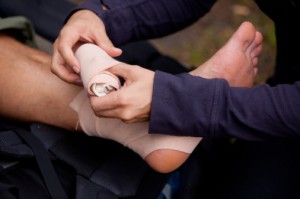High blood pressure is the second leading cause of kidney failure in the United States after diabetes.
High blood pressure, also known as Hypertension, can damage blood vessels in the kidneys, reducing their ability to work properly. When the force of blood flow is high, blood vessels stretch so blood flows more easily. Eventually, this stretching scars and weakens blood vessels throughout the body, including those in the kidneys.
If the kidneys’ blood vessels are damaged, they may stop removing wastes and extra fluid from the body. Extra fluid in the blood vessels may then raise blood pressure even more, creating a dangerous cycle.
Most people with high blood pressure do not have symptoms. In rare cases, high blood pressure can cause headaches.
Kidney disease also does not have symptoms during its early stages. A person may have swelling called edema, which happens when the kidneys cannot get rid of extra fluid and salt. Edema can occur in the legs, feet, or ankles and less often in the hands or face.
Once kidney function decreases further, symptoms can include:
- Appetite loss
- Nausea
- Vomiting
- Drowsiness or feeling tired
- Trouble concentrating
- Sleep problems
- Increased or decreased urination
- Generalized itching or numbness
- Dry skin
- Headaches
- Weight loss
- Darkened skin
- Muscle cramps
- Shortness of breath
- Chest pain
Following a healthy eating plan can help lower blood pressure. Your health care provider may recommend a dietary approach that includes foods that are low in fat and cholesterol, dairy that is fat-free or low-fat, fish, poultry and nuts, as well as, consuming less read meat, sweets and added sugars.
If you are experiencing symptoms and would like to speak with a physician, please call Flushing Hospital Medical Center’s Ambulatory Care Center at 718-670-5795.
All content of this newsletter is intended for general information purposes only and is not intended or implied to be a substitute for professional medical advice, diagnosis or treatment. Please consult a medical professional before adopting any of the suggestions on this page. You must never disregard professional medical advice or delay seeking medical treatment based upon any content of this newsletter. PROMPTLY CONSULT YOUR PHYSICIAN OR CALL 911 IF YOU BELIEVE YOU HAVE A MEDICAL EMERGENCY.




 “You can tell if someone has an eating disorder by looking at them,” “eating disorders are caused by a diet gone too far,” and “only young women are affected” are some of the popular misconceptions associated with eating disorders.
“You can tell if someone has an eating disorder by looking at them,” “eating disorders are caused by a diet gone too far,” and “only young women are affected” are some of the popular misconceptions associated with eating disorders.